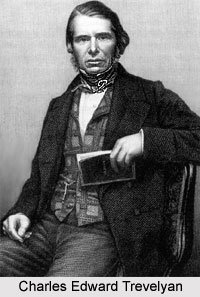 Charles Trevelyan served as one of the Governors of Madras Presidency from the year 1859 to 1860, under the rule of the British East India Company. He was formally addressed as Sir Charles Edward Trevelyan, 1st Baronet, KCB. He was also one of the well known British colonial administrators. Trevelyan also served as one of the members of the British Indian Civil Service, which was the civil service of the Government of India during the era of the rule of British Empire in India. The members of the civil service were appointed under Section XXXII of the Government of India Act, 1858 of the Parliament of the United Kingdom. After the year 1886, the Indian Civil Service was officially known as Imperial Civil Service.
Charles Trevelyan served as one of the Governors of Madras Presidency from the year 1859 to 1860, under the rule of the British East India Company. He was formally addressed as Sir Charles Edward Trevelyan, 1st Baronet, KCB. He was also one of the well known British colonial administrators. Trevelyan also served as one of the members of the British Indian Civil Service, which was the civil service of the Government of India during the era of the rule of British Empire in India. The members of the civil service were appointed under Section XXXII of the Government of India Act, 1858 of the Parliament of the United Kingdom. After the year 1886, the Indian Civil Service was officially known as Imperial Civil Service.
Charles Trevelyan is extensively credited for the reform of the British Indian Civil Service with recruitment of educated people who were suitable for designations. These positions were initially granted by aristocratic patronage. Trevelyan was regarded as the founder of the modern British Civil Service.
Early Life of Charles Trevelyan
Trevelyan was born as Charles Edward Trevelyan on 2 April 1807 in Taunton, Somerset in South West England. He was the son of the Venerable George Trevelyan, Archdeacon of Taunton, and his wife Harriet Trevelyan, the daughter of Sir Richard Neave. Charles Trevelyan completed his education from Blundell`s School, Charterhouse School and later studied at Haileybury, which was earlier known as the East India Company College.
Career of Charles Trevelyan
Charles Trevelyan was initially employed with the British government in Calcutta (now Kolkata), in former undivided India. Later during the late 1850s, he served there in senior-level appointments. Trevelyan acted as the Assistant Secretary to Her Majesty`s Treasury from 1840 to 1859. During this period he administered relief for the Irish famine and directed work of the Central Board for Highland Relief in the Highland Potato Famine of 1846 to 1857 in Scotland.
Sir Charles Edward Trevelyan, 1st Baronet, KCB was appointed as the Governor of Madras Presidency on 28 March 1859. He was preceded by George Francis Robert Harris, 3rd Baron Harris GCSI as the Governor of the Province of Madras. The Madras Presidency, also known as the Presidency of Fort St. George and Madras Province, was an administrative sub division of British dominated India. The territory included most of southern India, such as the modern states of Tamil Nadu, the Coastal Andhra and Rayalaseema regions of Andhra Pradesh, Lakshadweep Islands, the Malabar region of North Kerala, Koraput, Malkangiri, Nabarangapur and Gajapati districts of southern Orissa and the Bellary, Ganjam, Dakshina Kannada, Rayagada and Udupi districts of Karnataka.
Trevelyan served in office till 8 June 1860 and was succeeded by William Ambrose Morehead. Later Sir Charles Trevelyan acted as Indian Finance Minister from the year 1862 to 1865.
Literary Works of Charles Trevelyan
Sir Charles Edward Trevelyan, 1st Baronet, KCB wrote a number of literary works which included, The Application of the Roman Alphabet to all the Oriental Languages (1834); A Report upon the Inland Customs and Town Duties of the Bengal Presidency (1834); The Irish Crisis (1848); The Army Purchase Question and Report and Evidence of the Royal Commission considered (1858); The Purchase System in the British Army (1867)
The British Army in 1868 (1868); A Standing or a Popular Army (1869); Three Letters on the Devonshire Labourer (1869); From Pesth to Brindisi, being Notes of a Tour (1871); The Compromise offered by Canada in reference to the reprinting of English Books, (1872); and Christianity and Hinduism Contrasted (1882).
Personal Life of Charles Trevelyan
Trevelyan was knighted with Knight Commander of The Most Honourable Order of the Bath, also known as The Most Honourable Military Order of the Bath (KCB) on 27 April 1848. He was created a Baronet on 2 March 1874. Charles Trevelyan was married to Hannah Moore Macaulay on 23 December 1834 in British India. She was the sister of Thomas Babington Macaulay, 1st Baron Macaulay. The couple had a son Sir George Otto Trevelyan, 2nd Baronet, inherited the Baronetcy after the death of his father. On 14 October 1875, Charles Trevelyan was married for a second time to Eleanor Anne, the daughter of Walter Campbell of Islay. He died on 19 June 1886.



















